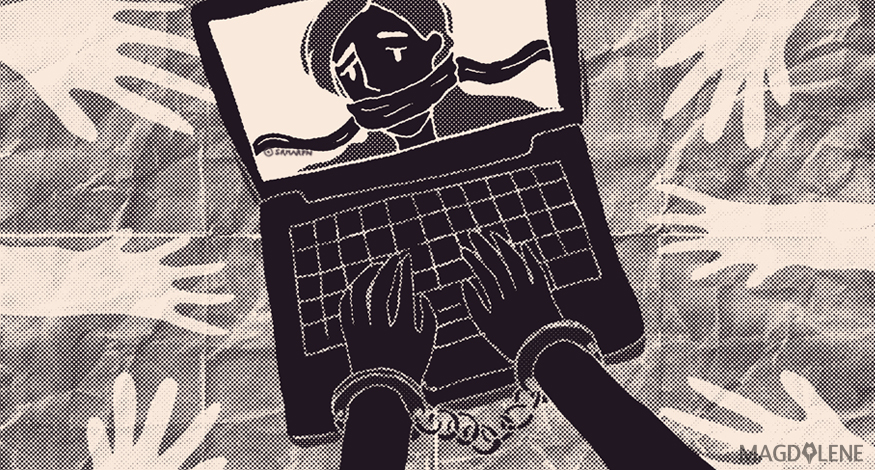One night in April last year, filmmaker Jennifer Kennedy Dhillon received a call asking her if she was available to give a massage. At first, she thought it was a wrong number, but the messages kept coming. Throughout the night, she received more than 100 calls and messages of the same nature, suggesting that she offered massage and sexual services.
This went on until September, by which time she had blocked more than 4,200 phone numbers that were sending messages containing pornographic photos and texts and from which sexually harassing calls were made.
“This terror started while I was working on a documentary about former Jakarta Governor Basuki Tjahaja Purnama,” said Jennifer during “Gender Based Violence Online” discussion at the National Commission on Violence against Women (Komnas Perempuan) on Jan. 28, adding it was later revealed that her harasser did not like her political stance.
She also found several Instagram accounts pretending to be her. Jennifer finally reported the harassment and her fake social media accounts to the police.
“I told them that I received pornographic texts and calls every day to the point that I didn’t even want to touch my phone, but they didn’t think it was a big deal,” said Jennifer.
Jennifer is not the only woman who has been the target of online abuses. Komnas Perempuan and Southeast Asia Freedom of Expression Network (Safenet) said that gender-based violence online (GBVO) cases have increased over the past year. According to Komnas Perempuan’s 2018 annual report on violence against women in Indonesia, there were 98 reported cases of GBVO throughout 2017.
Komnas Perempuan Commissioner Indriyati Suparno said the number of cases in 2018 had likely increases. The three most common GBVO categories are cyber harassment, violations of privacy and personal data (doxing), and the threat of spreading personal data.
“Violations of privacy often lead to pornography. There are many cases of threats to spread women’s personal photos or videos,” said Indriyati during the discussion.
She said that online gender-based violence never stood alone. There is always a real world dimension that is often used by the perpetrators to escalate the threat. For example, many abuse perpetrators who are those closest to the victims often threaten to spread the victims’ personal data.
“Wives who want to divorce their husband and report them for abuse would be threatened by their husbands, who said that they would spread their personal photos or videos,” said Indriyanti.
Nabilah Saputri from Safenet said many women are often attacked online because of their political stance as in Jennifer’s case. Attackers would use personal information that can be accessed on social media and spread them, she said.
“They search photos, videos and personal data of their targets. After that, they create a fake accounts and use it to harm the victim such as making statements that can backfire on the victim,” said Nabilah.
Difficulties in handling GBVO cases
Jennifer said that initially her report had not been responded well by the police. She was told by the police to gather the evidence and to conduct a search for the perpetrator herself. In addition, the police choose to handle her case using the Law on Electronic Information and Transaction (UU ITE), largely ignoring the sexual harassment dimension of the case.
Article 32 of UU ITE stipulates that stealing someone’s personal data online is punishable by law. However, it is insufficient to prosecute the gender-based violence dimension of Jennifer’s case.
Indriyati said the handling of the law related to GBVO can be confusing because of the use of the UU ITE and because investigators of the Police’s Cyber Crime Unit still don’t have gender perspective.
“UU ITE doesn’t provide protection to victims. Even victims could be suspects,” said Indriyati, referring to another case involving a teacher who was sentenced to six-month jail time and Rp 500 million (US$35,800) fines for defamation after screenshots of text messages of her being sexually harassed by the principal of her school was spread.
The police can actually handle cases that involve women and children victims using the National Police Regulation Number 10/2007 and the National Police Regulation Number 3/2008 which ensure that the victim’s perspective must be prioritized.
“But for GBVO cases, there is yet an agreement in the police on whether they should be handled by the cybercrime unit or whether they should be handled in coordination with the women and children unit in the police. This is why instead of getting justice, victims often end up being charged with defamation after they made their abuses public.
“This is why the Draft Law on the Elimination of Sexual Violence must be passed immediately because it covers different types violence against women,” said Indriyanti.
As for Jennifer, who received assistance from the Jakarta Legal Aid Institution, after insisting that the police stepped up their investigation, she finally got see the man who spread her phone number and who created her fake social media accounts arrested.
“He apologized and pleaded that I retracted my report, but I didn’t. The police and I had worked hard to catch him, so he must be held accountable for what he did,” she added.
Find out on why more urban women than rural women fall victims to domestic violence and follow @bunnnicula on Twitter.









Comments